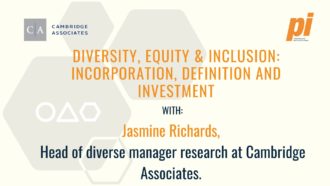What themes are key in the diversity debate within institutional investment?
There are three lenses I tend to consider when thinking about diversity in institutional investment. One of those perspectives is: is there enough diversity of ideas? By which I mean, when selecting investments, are the right ideas being suggested, critiqued, discussed and ultimately selected?
That’s the first perspective. But in order to do that, you need to have diversity of thought. You need to ensure that there is a fairly open, collaborative and inclusive environment where such ideas can be brought forward to be critiqued properly and the appropriate decisions be taken.
Diversity of thought brings us into how you might think about building a team, which is my third lens. When building a team, we need to consider a number of factors. We can have a team of people who share a similar background in the way they think, so are not necessarily diverse in the way they generate ideas. So that diversity of thought perspective applies internally [as an organisation] and also externally [as an industry].
So when selecting investment managers, who run capital on behalf of pension funds day-to-day, consider if they are diverse in the way that they think, critiquing ideas and ultimately factoring those into the portfolio construction process?
Of those themes, which is the most important?
I see them as interlinked. It is difficult to suggest that one is more or less important than another because they all contribute towards strengthening the decision-making process and that permeates through each investment decision investors make.
The critical point around the diversity of thought piece is how can it be understood, conceptualised and ultimately factored into decision making.
What ideas are being generated from that diversity of thought process?
It is more from a principle perspective. During the past 12 to 24 months, it has been a pretty challenging market environment. There has been lots of volatility and lots of shifts in the way that the market is evolving. It is, therefore, important to consider alternative ideas to those you have perhaps chosen during what has been a more benign period in the past decade or so.
We are in a changing state of flux. We need to make sure that there are ideas being brought in which are adaptable to the current state of affairs. Diversified alternatives are, for example, one perspective that may be relevant. But in order to do that you need to have a well-equipped team to be able to assess that and under- stand the opportunity set.
Is the industry embracing these ideas, or do we still have a long way to go?
This is evolutionary. I have seen a lot more focus on diversity within the investment industry. It probably comes as no surprise that the investment industry in terms of people composition tends to be fairly standardized. There is less representation of people from a lower socio-economic background, for example.
But there are necessary points to look inwards, to understand why that’s the case and understand what can be done to change that. The industry is willing to do that, but it will take time.
We are at an evolutionary point that will take some time to play through.
Do you think the socio-economic and mobility narrative has been put on the back burner in favour of other narratives, such as a focus on gender and race?
It is a good question. More easily observable characteristics, such as gender and race, can be easier to focus on. One could argue that something like socio-economic mobility is more di cult to measure.
Is the launch of the City of London Corporation-led Socio-Economic Taskforce to address this issue a step forward?
All initiatives in this space are a step forward. It is important that we recognise that there are desirable evolutions, they are relative to the current position and look to change those.
A focus on these issues is a positive step, but, as I have said, it will take some time.
Is another issue one in which these initiatives exist in something of a vacuum, undertaken by particular individual organisations, but do not exist holistically as an industry. Therefore, is there an impetus to change them across the board?
It’s an interesting point. What I would point to though is there are a number of quite large industry collaborations on this. The Diversity Project is a widespread initiative, for example. This type of collaboration illustrates what I talked about earlier in terms of that genuine willingness from the industry to make progress in this area.
How should the industry deal with the social mobility narrative and switch the dial forward to get something done?
Some real positives I see are at the early career stage. When organisations are looking to bring in new talent and look at the junior level to do that, then one area where we have seen some development is no longer exclusively focusing on graduate recruitment.
Here the thinking has been about apprenticeship recruitment or opening up recruitment opportunities to those who may not have gone down a traditional educational path. That is positive.
Secondly, even when looking at graduate recruitment, doing that on a basis which is deviating a little from the traditional or historical perspective of only looking at red brick universities or Oxbridge, are the focal points in terms of bringing in that talent.
One of the things we have done, and done for a number of years now, is redacting the university information from graduate CVs when they come in. We are trying to minimise bias in terms of the recruitment process.
So there are some quite easy and meaningful steps organisations can take in order to broaden the potential pool of talent and consider the way they are assessing that talent and bringing that into the organisation.
That means the industry has to take a step back and look at who they are recruiting instead of just promoting people within the organisation from a particular background. They have to step back and get involved in education and universities.
That’s right. You mentioned promotion. That is crucial in terms of internal promotion processes that also need to be considered here.
Again, that’s something Aon has done a lot of work on. I’m sure other organisations have done so similarly in order to think about the degree to which those processes are inclusive: that they are open and accessible.
So that such people who may not be at the point of being ready for promotion or those who feel that they are ready for promotion, see a clear roadmap as to how they could progress to that next stage in their careers. Internal promotion processes are important to think about, as well as that more outward looking external recruitment point.
How can we turn these initiatives and ideas into standardised objectives? Who needs to get involved to bring all this together?
Joined up thinking is absolutely key. To that end, what I would point to is individual organisations undertaking their own initiatives relative to cross-industry collaboration. This is an area where cross-industry collaboration is powerful. I would look to initiatives such as the Diversity Project in order to benefit from cross-pollination of thinking and developing internally by using those.
Is the institutional investment industry going in the right direction on diversity?
I do see there being some real positives here. From a personal perspective, I’m married to a woman. I’m gay. I feel more than ever before absolutely accepted and included within the industry that I work in. I feel happy about the position I’m in.
But I also have to say that wasn’t always the case. I’m working in the investment industry, but it wasn’t always inclusive in the way that I perceive it to be now.
I do feel that there are some real positive developments here and I hope that others feel similarly.
What would you suggest as the key takeaways from this?
The key takeaway is to think about: are you considering how you are making decisions. Really consider the teams that you are part of. And if you feel that you have a diverse representation of thought around the table, think also about the way that you measure and consider diversity.
We have talked a little bit about observable characteristics relative to those, which are less easily observable. So consider the extent to which that may be the case and look to those external collaborative initiatives that I talked about in order to benefit from the huge wealth of thought leadership and ideas that are coming through.





Comments